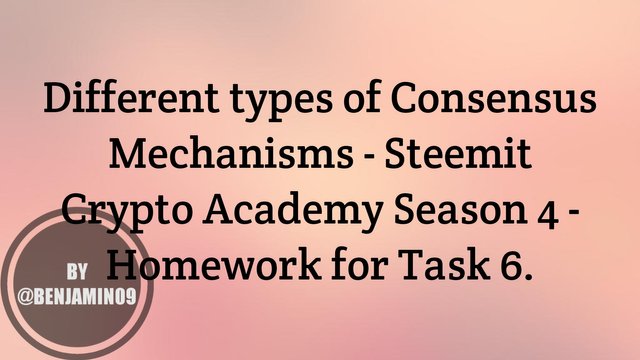Different types of Consensus Mechanisms - Steemit Crypto Academy Season 4 - Homework Post for Task 6. | by @benjamin09
Question
(2) What is the difference between PoS & DPoS? Advantages & Disadvantages? Name a few Block chain projects which use the DPoS consensus mechanism and indicate the scaling capacity?

ANSWERS.

What is the difference between PoS & DPoS?

POS is a consensus mechanism where the block creator/validator, is determined based on his economic stake and incentive mechanism in the block chain’s native coin. This means that, the higher the stake, the more likely to be selected as the validator and the lesser the stake, the less likely to be considered or chosen as the block validator.
While with DPoS, it deals with a consensus mechanism where the elected delegates are the validators of the block network. With DPoS, a stakeholder can vote on a delegator based on his stake in the block chain’s local coin. This means that, the higher a stakeholder’s stake(amount of native coin), the more influence he will have on voting a delegate and the lower a stakeholder’s stake in the block chain, the less influence he will have in voting for a delegator.With PoS, the stakeholders are the ones who directly validate the block network. But as for DPoS, the voted delegates are the ones in charge of validating the network.
With DPoS, there are different witnesses for every block on the block chain, whereas with PoS, all stakeholders validate the network.
PoS networks fall victim to short range attacks while DPoS do not fall prey to short or long range attacks as most of them use BFT (Byzantine Fault Tolerant).
With DPoS, the network can start only with a few nodes and this takes away the idea of it being a public block chain while more nodes are required to start a PoS block chain.
With DPoS, the block creating time can be really fast (the case of few nodes which are close to each other) but as for PoS, the block creating time can only get fast while dropping its security protocols.
With DPoS, there is no forking possible (it has finality) while PoS does not have this feature.
Some information for this question was gotten from this website

Advantages & Disadvantages of PoS.

Advantages.
- There is little energy consumption as no hardware capacity is required or huge amounts of electricity is needed for the block chain.
- It is cost efficient as little or no hardware is needed to be bought to start the block chain.
- The user has to acquire tokens in order to participate on the block chain and this reduces the need to advertise the token thus cost efficient for the producer.
- Rewards are spread proportional to the amount of assets in store and this helps reduce the risks of centralization.
- PoS also helps the token’s dynamics since a particular proportion is always locked in.
Disadvantages.
- Since tokens are kept in the account to keep earning premium, they are not used to trade with other transactions and this increases risk in case of attack as all will be lost.
- With PoS, the block creating time is slow and if it is done any faster, the security measures will have to drop.
- A single user can create a secret block with fraudulent activities on PoS and when the block becomes larger than the prior, it can get validated by other stakeholders ignorantly.

Advantages & Disadvantages of DPoS.

Advantages.
- There is faster processing of transactions than PoW and PoS and thus, there is scalability and speed in DPoS.
- There is no hardware required for the network to start. And also, there is little energy consumption.
- People or users of the block chain behave themselves as they can be down voted and their reputation can be dropped in case of malicious activities. This goes same for delegates as they can also be voted out from their positions.
Disadvantages.
- An attack can be launched where the attacker gains control of 51% of the shares and thus leaves no room for a counterattack from the network delegates.
- The more tokens you have on a DPoS network, the richer you get thus really creating a gap between the rich and the poor.

Name a few Block chain projects which use the DPoS consensus mechanism and indicate the scaling capacity?

Some of the networks which use the DPoS consensus mechanism include the following:
- Lisk
- EOS
- Steem
- Tron
- Cardano
- Nano
- Ark
From the above networks, we will look at 2 for their scaling capacity. We will see Steem and Tron.
a. Steem.
Steem has a total of 21 witnesses who are in charge of creating and validating new blocks for the block chain. A new block is created in the Steem blockchain every 3 seconds. And for each 63 second round, the 21 Steem witnesses produce 21 blocks.
b. Tron
Tron has a total of 27 representatives who are voted by Tron nodes. Tron handles millions of transaction per month and the algorithm was created such that it can evolve to scale. Transactions are processed on Tron every few seconds.

Conclusion

After completing this task, I know the differences that exist between PoW, PoS and DPoS as well as their various advantages and disadvantages. Also, I have learned the scaling capacity of DPoS networks like Steem and Tron.